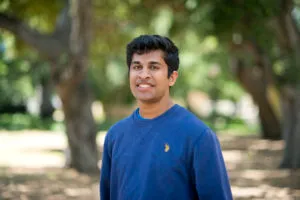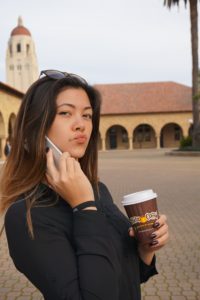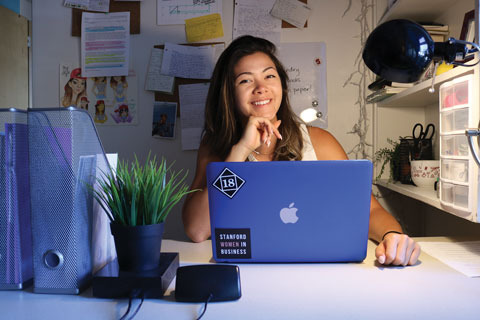A violinist who covers pop songs; a comedian who parodies music videos; a blogger who turns her camera lens on her own life at Stanford. The Daily talked with three Youtube-famous Stanford students about the origins of their channels, the evolution of their videos and their plans for the future.

Akshay Dinakar
Akshay Dinakar ’19 makes violin covers of pop songs for his YouTube channel, “Akshay Dinakar Music,” which has nearly 1,400 subscribers.
The Stanford Daily (TSD): What made you decide to create violin song covers for YouTube?
Akshay Dinakar ’19 (AD): I started playing violin when I was three. I was originally trained classically, but then in middle school, I really got into jazz and improv, and then in high school, I had a lot of fun taking my violin to school in the mornings and bringing my electric violin and amp. I would play Disney songs in the hallways, and students really enjoyed it. I had a lot of fun doing it for my high school, but I thought it would be even more fun to share with a wider audience, and since most of my relatives are in India, I think that YouTube is a great way to send stuff to them. … YouTubing is a self-paced, fun way to stay in touch with your creative side and make people smile at the same time. … I think it’s nice that YouTube can bring together strangers from all around the world to appreciate good quality art and content.
TSD: Has it been difficult to maintain your YouTube channel since coming to Stanford?
AD: Definitely a little bit. I get pretty busy and I try and keep YouTube involved in different ways. Last year I founded Stanford Flash Mob Orchestra, which is my ensemble here. That group basically creates spontaneous arrangements of flash mob pieces that we perform around campus for YouTube. … Doing something like that, as well as school, takes away time from my own personal YouTubing, but it’s always the sort of thing where if I get tired of school or want a one-hour break just to have fun, I’ll churn out a YouTube video. It’s something that, over the past two years, I always did as a creative outlet or a break, but over time I’ve also gotten more serious about it.
TSD: Has your video style changed since coming to Stanford?
AD: Now it’s becoming more and more planned, which also means that the quantity of my videos is going down, but the quality is increasing a lot and I’m definitely trying out new things. I originally used to just set up a microphone and get out my violin and just record whatever video was right there when I was doing it, and I could make the whole thing in under an hour. Recently I started getting more into music videos. I record it and then I go to some aesthetic-looking place to play.
TSD: Do you think YouTube has changed the music industry?
AD: It’s interesting as a YouTuber to find this balance, since it’s such a public form of art, between creating content for others and creating content for yourself. … I’m in an art class right now, and one of the biggest discussions we’ve been having is the effect that reproductions have had rather than original pieces of art. It’s very similar [with violin]. Now when someone creates a piece of music, when you think of an artist releasing a piece of music, it’s not just the piece of music itself. There [are] so many other things [that] make money alongside that. You have the music video, Spotify, iTunes. You’re creating something that is not just a live performance but something that is meant to be watched over and over again. In fact, you kind of keep that in the back of your mind when you YouTube. You want something that is catchy, something that goes viral. … Totally changes the way you approach things.
TSD: Do you have any future plans for your channel?
AD: While I’m very happy with the stuff that I’ve put up so far, I always think that there are ways to grow, and I’m chasing that dream of creating something that will hopefully go viral and that tons of people will enjoy, but hopefully will also be something that I am proud of. … So far in my channel, I’ve been playing other people’s songs and making covers, but my dream has always been to make my own music. So, I’m really excited to be releasing my first original pop violin single pretty soon. I’m teaming up with Punya Chatterjee. He’s going to be filming the music video for my original song that we’re doing with Common Origins, the dance group.
TSD: Do you have any fun YouTube anecdotes?
AD: I think the coolest thing that’s ever happened to me on YouTube was I made a cover of the song “Heroes” by Alesso. … And the day after I put this video up, I just got a ton of comments that [were] like “Yo check his Snapchat.” And so I went on Snapchat and I found out that Alesso has one of those celebrity Snapchats, so I followed it, and Alesso’s SnapChat was of him watching my cover of his song with the caption “This is fire.”

Catherine Goetze
Catherine Goetze ’18 has a YouTube channel, “Cath in College,” where she posts videos of her life at Stanford. The channel has about 17,500 subscribers. Goetze also has a blog, cathincollege.com.
TSD: So “Cath in College” originally started as a blog, but how did you expand to videos and other media?
Catherine Goetze ’18 (CG): I’ve actually been making videos since high school. Basically what I did in high school was videojournalism, but when I got to Stanford, I stopped for a bit just to adjust to school and to Stanford life. … Then I started specifically making videos for “Cath in College” not really with intention until the summer after freshman year.
TSD: Has your style changed since the channel gained popularity?
CG: At the beginning, it was still totally creating videos just for fun. … I started taking a little more time and care and became much more precise with audio and storylines and storytelling in general. I think that made a world of a difference.
TSD: Especially with a larger audience now, how do you choose your content?
CG: There are always certain types of videos that will get more views and increase your sub-count, for example. So it can be tempting for some people to just always make those types of videos. The problem arises that… in my case, those videos are not the kind of videos that I like to make and videos that don’t represent me as a person. Videos like how to get into Stanford and how to write a college essay … and to claim that you’re a knowledgeable source that everyone should be referencing for these kinds of decisions and these kinds of life decisions I just think is completely absurd. … So I have done as good of a job that I think I could have done at targeting high school students who are applying to schools like Stanford and [saying], “Give it your best shot, but know that you can have as good of an experience as I am having at Stanford at any other college, depending on your mindset.” If you go into a college thinking this is going to be the best four years of your life, you would be surprised at what you can make of it.
I think that this message has gotten across pretty well in the content of my videos and I will always hold this as a core tenant of my “Cath in College” videos.
TSD: What are your favorite types of videos to produce?
CG: The ones that are totally effortless in terms of filming. So for example, when my friends and I go out and I turn on my camera and just hold it in my hand and let my wrist follow the action. So those are my favorite types of videos: the ones that you watch and think are scripted and that they’re actors, but they’re totally free.
TSD: Do you ever worry about how much content you publish online?
CG: The limit, or where you draw that line, is something that I think about really often just for my own personal privacy and personal sake, but also for the sake of my friends and family and other people [who are in the videos]. I guess that the best answer that I have to that is just that I always try to stay mindful of that and to exercise caution … when I include any personal information.
TSD: How do you see the future of “Cath in College” when you’re not, you know, in college anymore?
CG: Yeah, I’m really glad you asked that. … My [content] is very much tied to a larger institution and a place and I’m mindful of that. My goal has never been to sell the University in any way, shape or form, but rather to celebrate how happy I feel here and the things that I have enjoyed here and to show people that they can have that joy no matter where they live. In terms of after-college plans, I don’t know yet. I know my interests are somewhere in the media and communications space.

Punya Chatterjee
Punya Chatterjee ’19 makes sketch comedy videos and music video parodies on his YouTube channel, “GeekSlayer,” which has over 77,400 subscribers.
TSD: How did you get into making comedy videos and parody videos?
Punya Chatterjee ’19 (PC): Well, I started making videos for my channel back in seventh grade. I just wanted to make my friends laugh, and so I would film videos with a crappy camera my parents had and just make little skits of what I found funny, put them up online.
TSD: How has YouTube changed since you were in seventh grade?
PC: YouTube has become a very commercial-based platform. … I honestly view them now as caring more about their advertisers than about their creators, which is why recently there’s been this massive exodus of YouTubers quitting, actually.
TSD: Are you going to be part of that exodus or are you going to stick around?
PC: I think I’m going to stick around. But… it is something interesting that I’m keeping in mind. It’s what I’m writing my RBA [Research-Based Argument] about actually, in PWR [Program in Writing and Rhetoric].
TSD: How did you distinguish yourself from other comedy videos and parody videos on YouTube?
PC: I think a big thing that set me apart was I made a lot of videos for an Indian audience, and being Indian myself there aren’t a whole lot of us on YouTube. … We’re not that represented in media anyway, so it was kind of appealing to other Indian people, seeing people making fun of they way they grew up, or of things that they say in their own lives. Other than that, my music video parodies would always be pretty prominent because people would search for them.
TSD: Has your channel changed at all since you came to Stanford?
PC: I definitely don’t have as much time to make videos anymore. I’ve wanted to shift my channel to slightly more mature content that would appeal more to people of my own age group, like to college students. But because I started my channel so long ago, I do have kind of a younger following, so there’s kind of a struggle there about what should I make versus what I want to make.
TSD: Could you just give an example of the kind of videos you want to explore more?
PC: Well, I’m in a sketch comedy group on campus, the Robber Barons, and I make sketches with them. We do a show every quarter. And I feel like I have freedom there. I have [the] comedic freedom to make more adult jokes, to swear, to do things… that wouldn’t fall under the category of parodies or Indian sketch comedy. So I kind of want to branch into doing that more on my channel.
TSD: What’s your favorite video that you’ve made?
PC: I really liked my “Black Beatles” parody that I made in December or my “Work” parody that I made in March – last March… I had a great time filming them because I enjoyed making the song and the parody itself. I had fun getting a lot of friends involved being background dancers, characters. I went to a bunch of different locations and shot. So filming was fun, and then those are two of my most successful videos… from the past year, so that’s nice, too.
Contact Sophie Stuber at sstuber8 ‘at’ stanford.edu.
